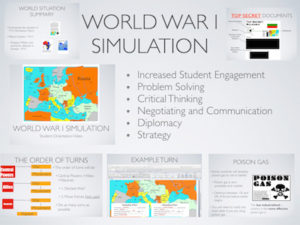Using gaming in social studies classes is a fairly new concept to most teachers. In actuality, simulations have been used for quite a few years, but maybe not to the level of HistorySimulation.com’s WW1 simulation games. In Mr. Harms’ version of the epic WW1 conflict, students are assigned countries and given tasks or objectives to accomplish during the activity. These objectives mirror the objectives countries had during the Great War. With the outcome of this conflict not guaranteed, students become very competitive to try and achieve their objectives. With sixteen countries and as many as 30 or more students involved, in some cases, it’s not hard to see how this could develop into a very intense and engaging lesson! With HistorySimulation.com’s new online platforms, the teacher is easily up to the task of controlling the simulations from their computer. If the students are in a one-on-one technology situation with a common VPN connection (sneak a peek at Expressvpn vs Ipvanish features here), they can have access to the maps online and can even update them automatically by simply refreshing their browsers. The engagement in the classroom soars through the roof as students compete with each other.
Some teachers kind of fear this type of lesson, because they think students will just sit there and do nothing. As soon as the first set of students leaves the room to negotiate, the wheels start spinning and everyone starts talking to their allies. Soon the entire room is engaged in talks with each other and strategies start to develop as they prepare their armies for battle. If you’re wondering how a battle is conducted, I’ll describe it for you.
Let’s say that Germany and Austria-Hungary have made the decision to attack Serbia. Both countries will sign declaration of war slips that indicate how many troops each is sending into the battle as well as the region, in this case Serbia, that they are attacking. Both leaders, or their representatives, now bring the slips to the head table (Teacher) and turn them in. The battle is announced to the class and Serbia, in this case, has the chance to pull in alliances to help defend them. The only troops that can make it to the battle have to be within one zone of movement or they cannot participate. Once this has been decided, the teacher drags the armies into Serbia and double clicks on the Serbian region. The battle is automatically calculated, a small ball of fire explodes on the map and the defeated armies disappear and the remaining forces of the victors remain. The same process is used until all the alliances armies have been used once, or as much combat as they wish to do. The one constant rule is that you can only use your army once per turn. When everyone in the alliance has finished combat, then they can move any forces that were not used during this turn to get into strategic positions for the Allies turn, which is next.

